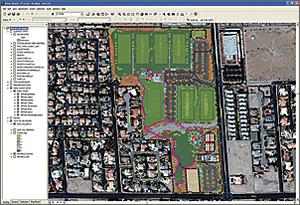City of Las Vegas Implements ParkPAD for Mobile Asset Management
Highlights
- Based on ArcPad software, ParkPAD streamlines the city's capability to collect and manage park assets.
- Data collected is fully compatible with the GIS department's existing ArcGIS enterprise system.
- Field crews now view a digitized image of a park or other venue and immediately see whether the data has already been collected.
Founded more than 100 years ago, Las Vegas, Nevada, began as a stopover on the pioneer trails heading west. Soon it evolved into a popular railroad town and staging point for the many mining operations in the area. In 1911, the population was about 800 people. Las Vegas then began to grow in leaps and bounds, with construction of nearby Hoover Dam during the 1930s and the beginning of its now massive casino industry during the 1940s and 1950s. Today, the Greater Las Vegas metropolitan area is home to nearly two million residents.

All American Park showing the base layers and assets added over the aerial image, which helps those using the map understand what they are looking at.
Maintaining the infrastructure necessary to support a population of this size requires carefully coordinated efforts by the city's Department of Operations and Maintenance to minimize redundant work and make the most of shrinking city coffers during difficult economic times. While the department has used ArcGIS software for many years, a different vendor's maintenance management system (MMS) had been implemented to collect and manage the assets within its parks and related facilities. Because the drawbacks of that particular system were substantial, in 2009, the Department of Operations and Maintenance began the development and deployment of its Park Asset Data Collection and Data Conversion Program (ParkPAD) to replace the legacy MMS. Based on ArcPad software, ParkPAD has greatly improved the department's capability to collect and manage park assets because it is fully compatible with the department's existing ArcGIS enterprise system. Field crews can now view a digitized image of a park or other venue and immediately determine whether the data has already been collected. Getting data in and out of the new system is a quick and easy process, and updates can be performed in near real time.
The Parks and Open Spaces Division is currently working with the Information Technologies Department to complete the digitization of the base layers for all the city's parks, landscaped areas, trails, medians, school landscaping, and sports fields. This new parks inventory database has produced some immediate cost benefits to the city. Since Las Vegas is in the Mojave Desert, water conservation is very important. The vegetation layers in the database are used to determine the square footage of each park so that the necessary amounts of seed, fertilizers, and herbicides can be accurately calculated and purchased. In a related project, the data from an earlier tree study was added to the database so that the parks maintenance staff could determine water usage requirements for each tree based on species, size, location, and so on.
In the next stage of the project, an irrigation layer will be created for the database and will include the locations of irrigation clocks, stations, valves, and controls. This will allow the irrigation system repair crews to quickly locate equipment when there is a break in the water main or if a valve becomes inoperable. In addition, these new base layers will make it easier to collect and track the number, location, and condition of assets, such as playgrounds, shade structures, drinking fountains, picnic areas, and benches.
This new data will be included in the city's enterprise GIS so that it is available to the other departments that rely on it. Currently, these departments maintain their own datasets for park assets, and there are discrepancies between them. Using the same dataset is particularly useful for the Department of Operations and Maintenance, which maintains the parks, and the Department of Parks, Recreation and Neighborhood Services, which schedules outdoor events, maintains sports fields, and manages the use of picnic and other recreation areas.
"Our use of GIS continues to grow," says Joel Hillhouse, GIS analyst at the City of Las Vegas. "In the near future, we will be posting our parks data on the city website for residents and visitors so that they can find information and make reservations for a specific site using an interactive park finder."
For more information, contact Joel Hillhouse, GIS analyst, City of Las Vegas (e-mail: jhillhouse@lasvegasnevada.gov).